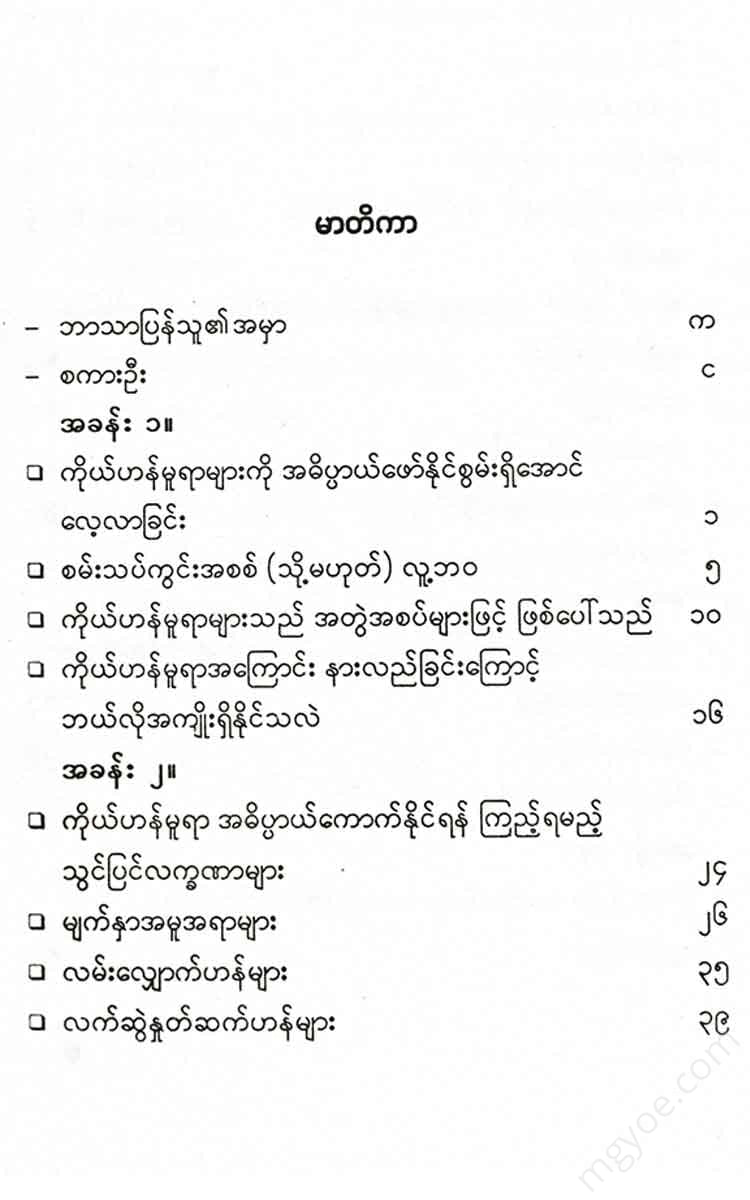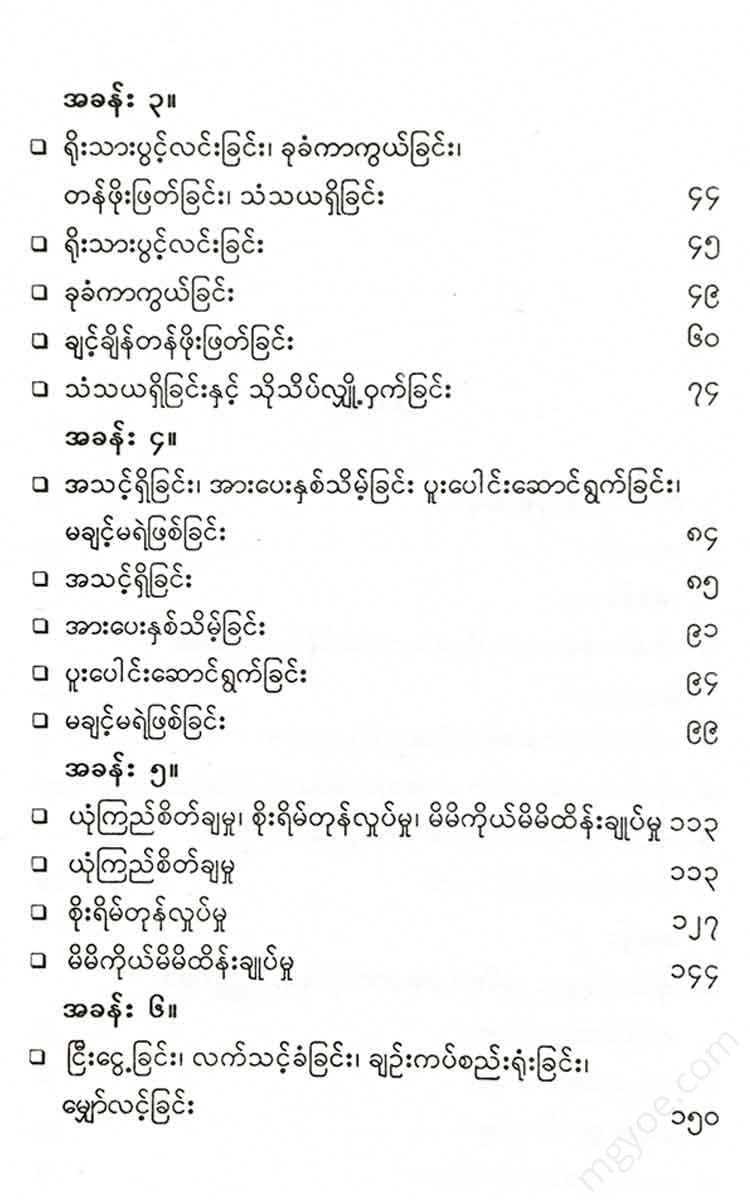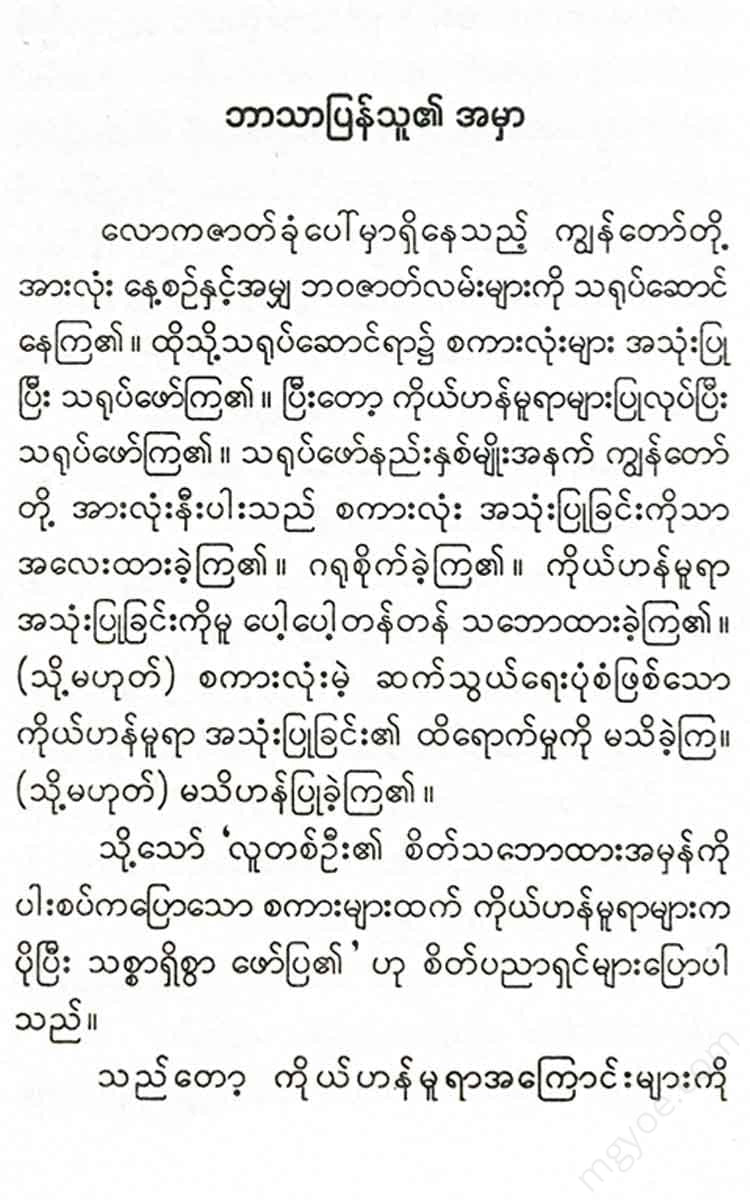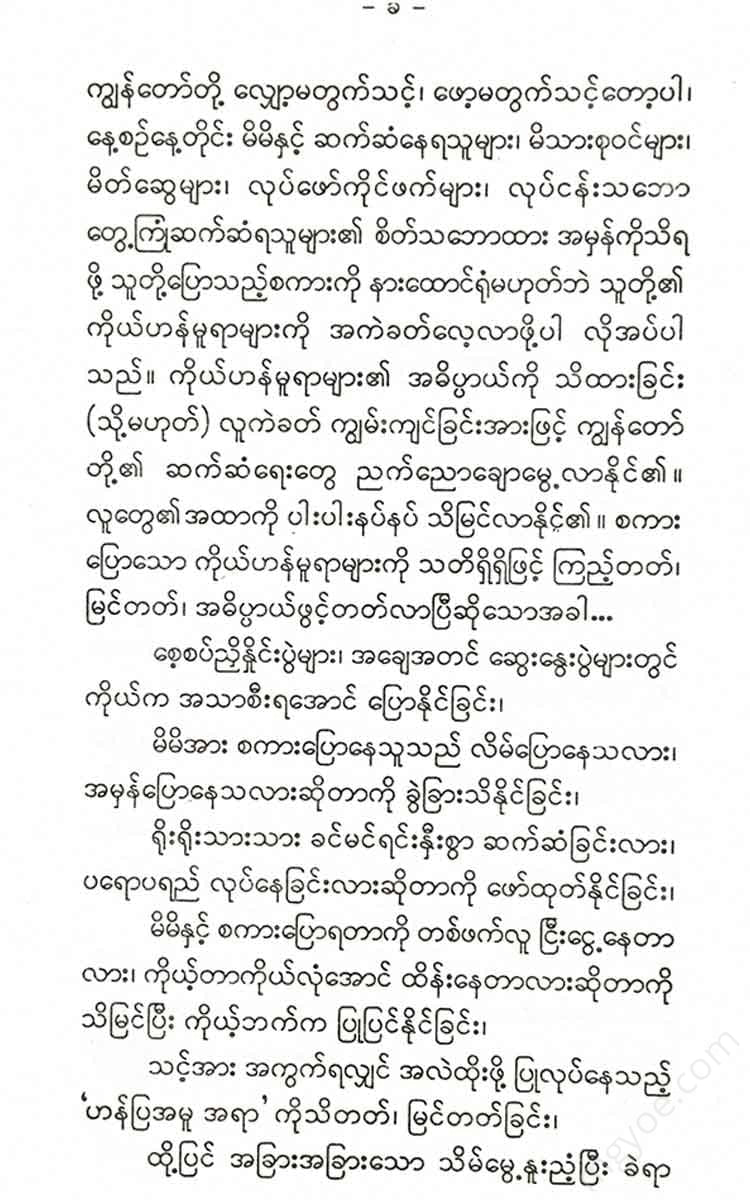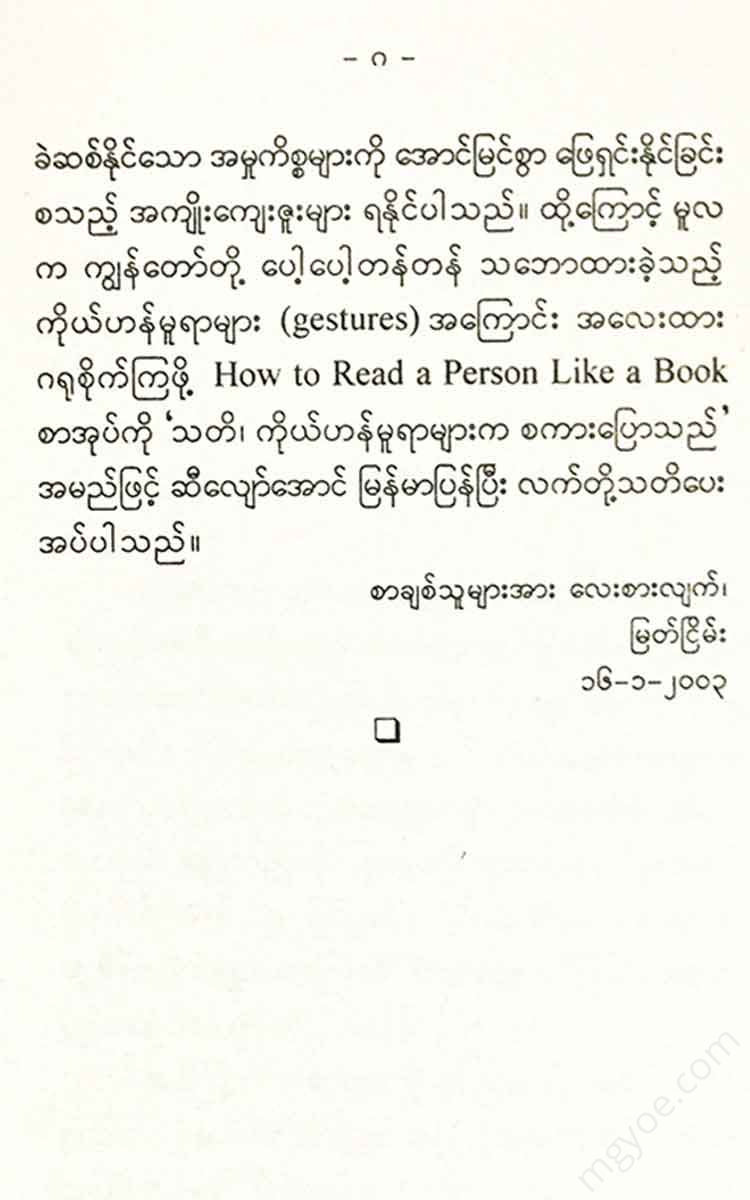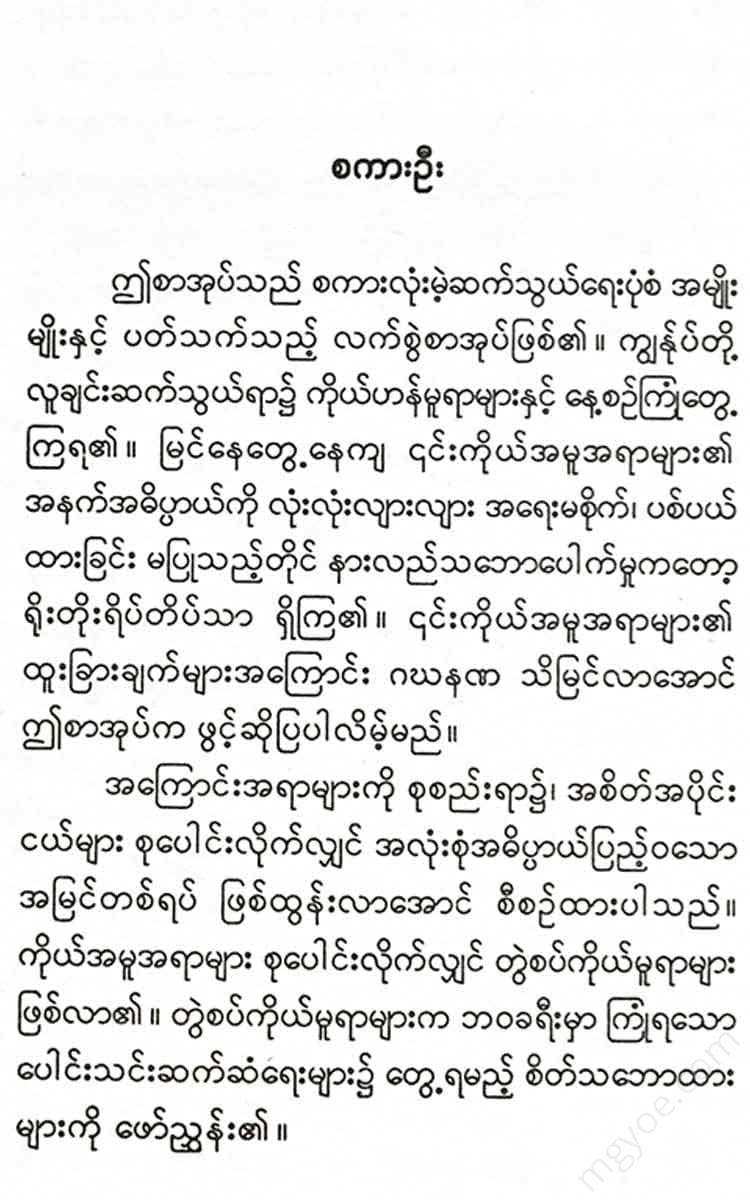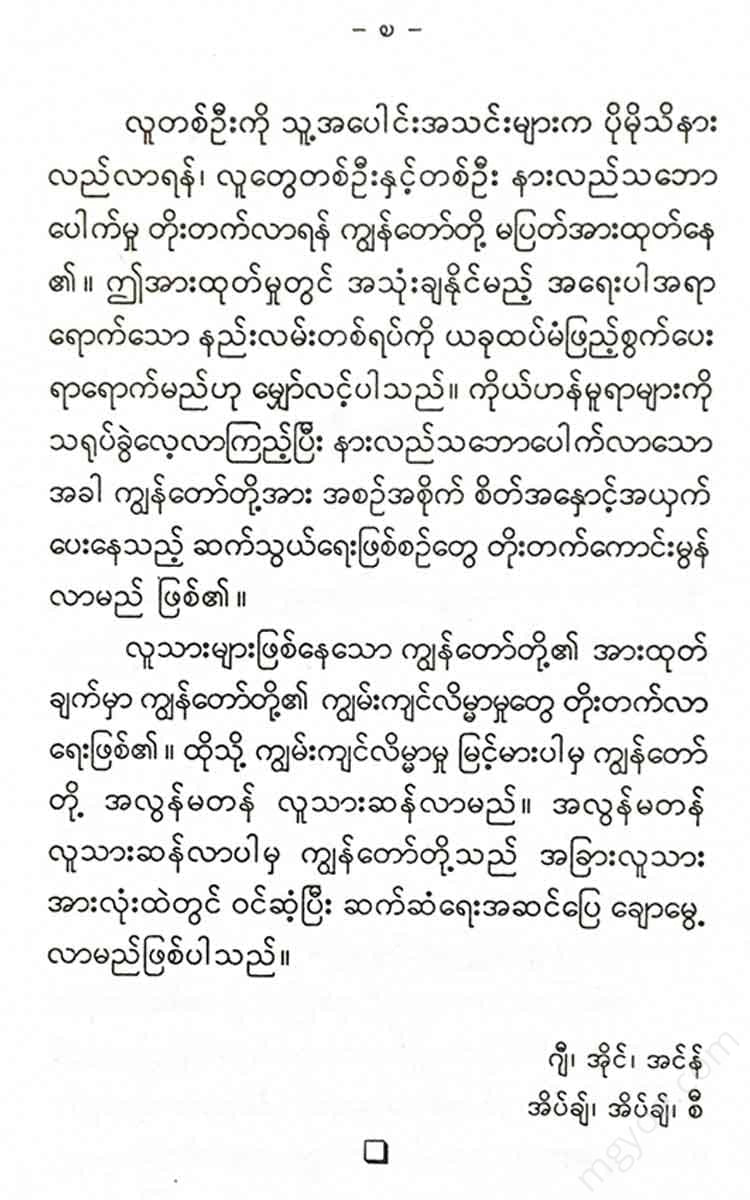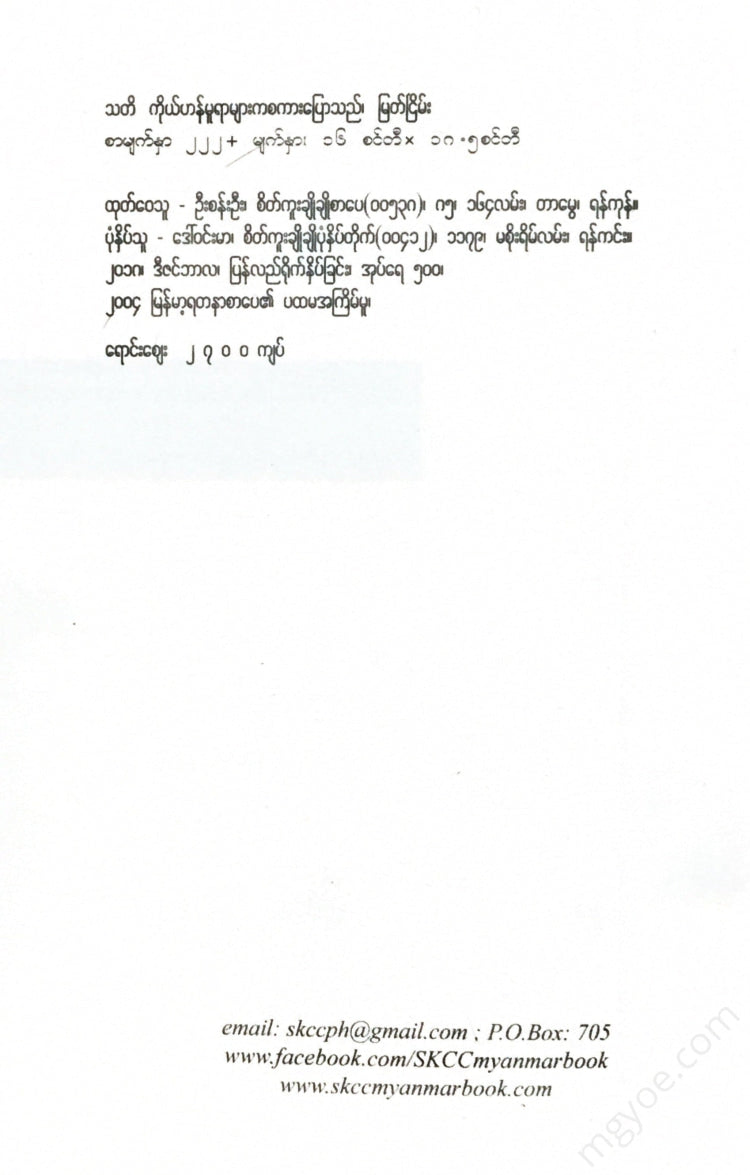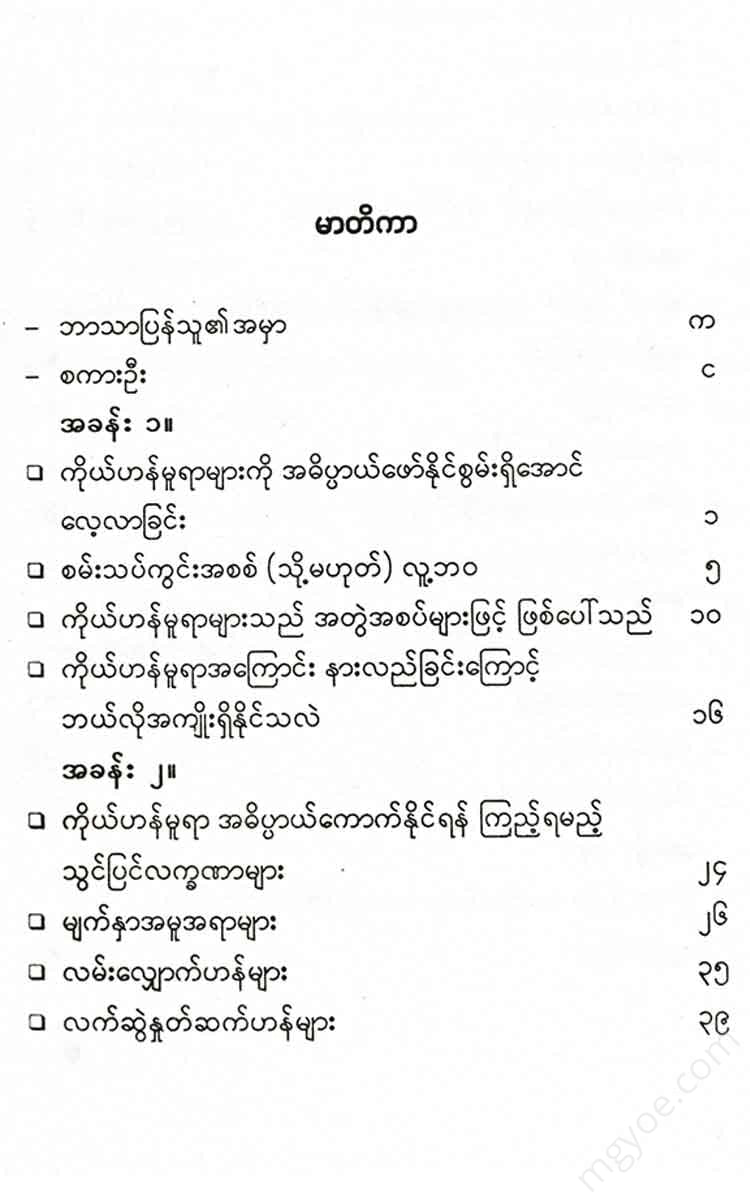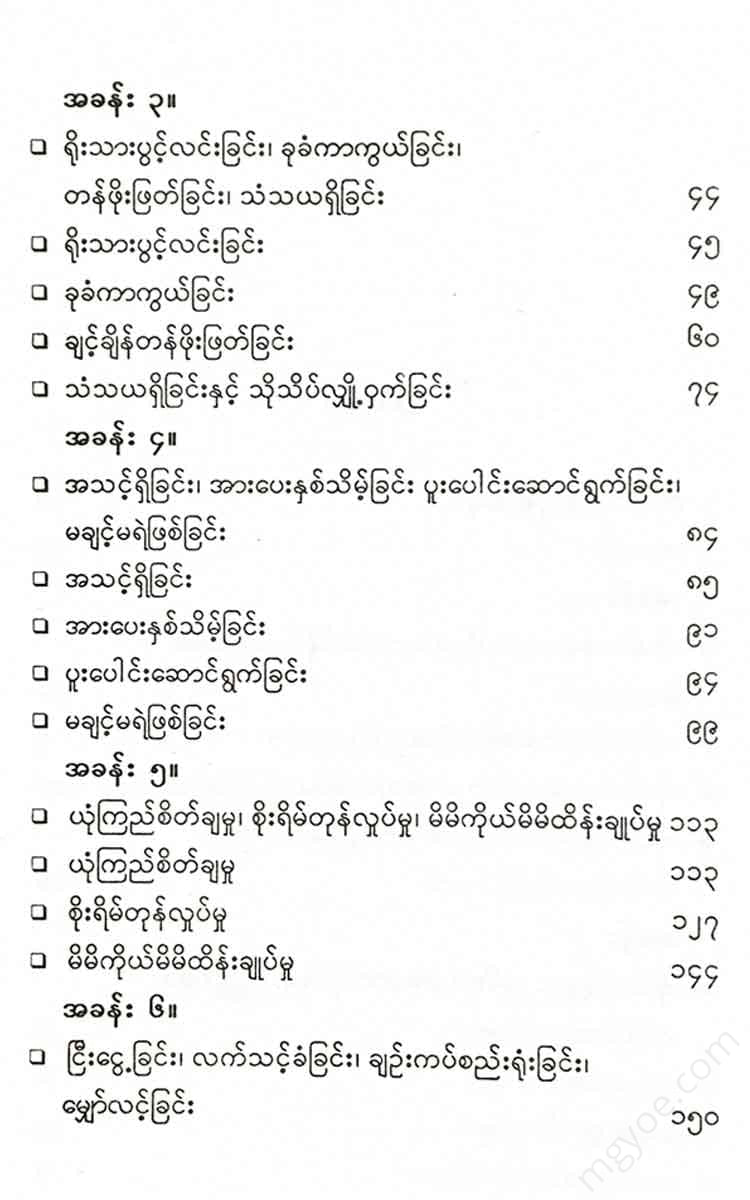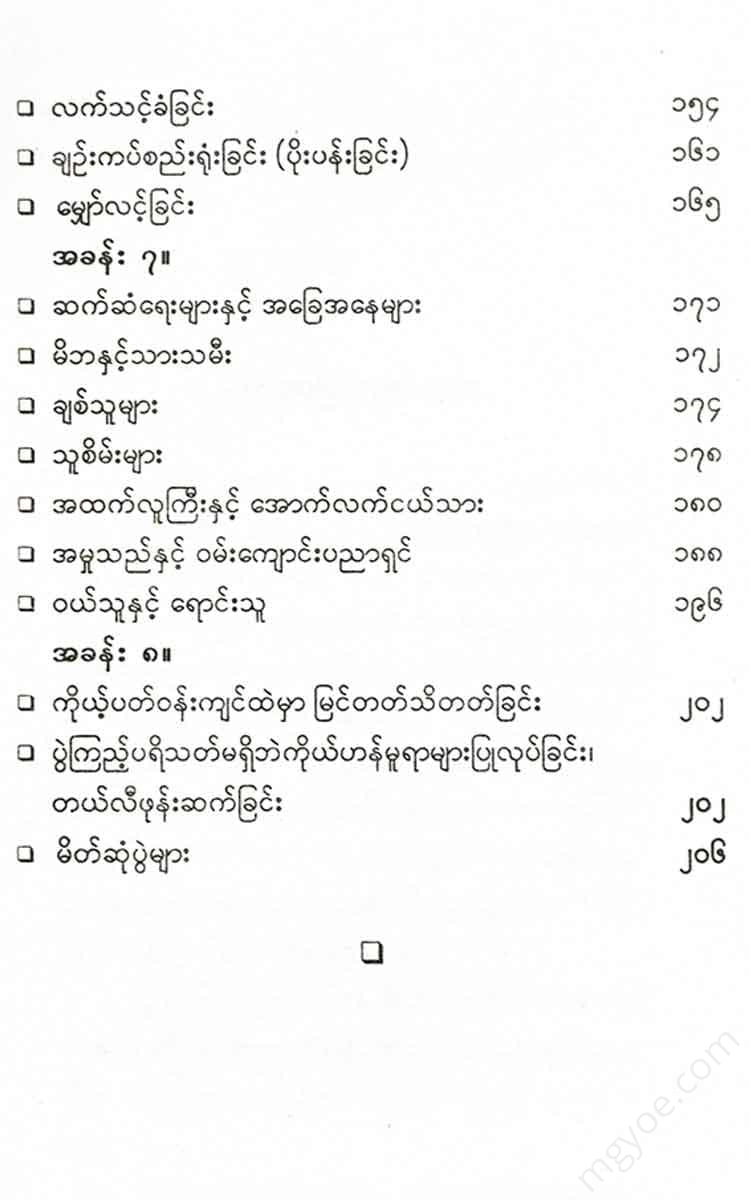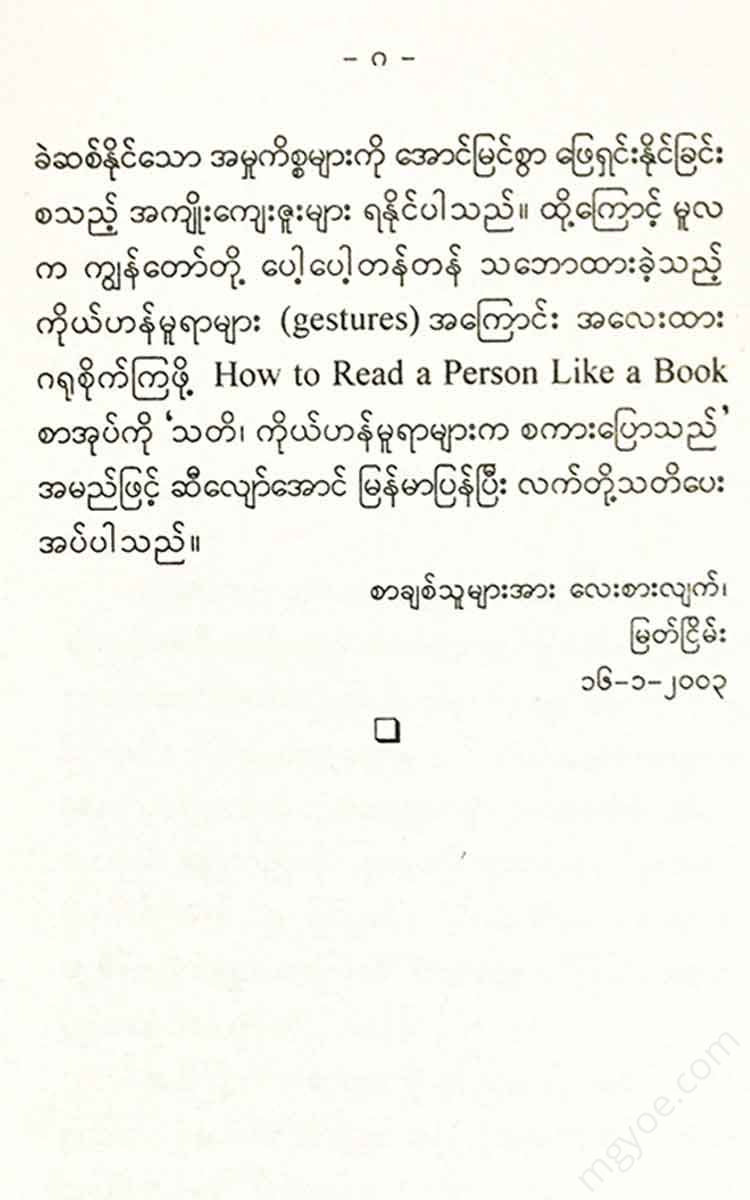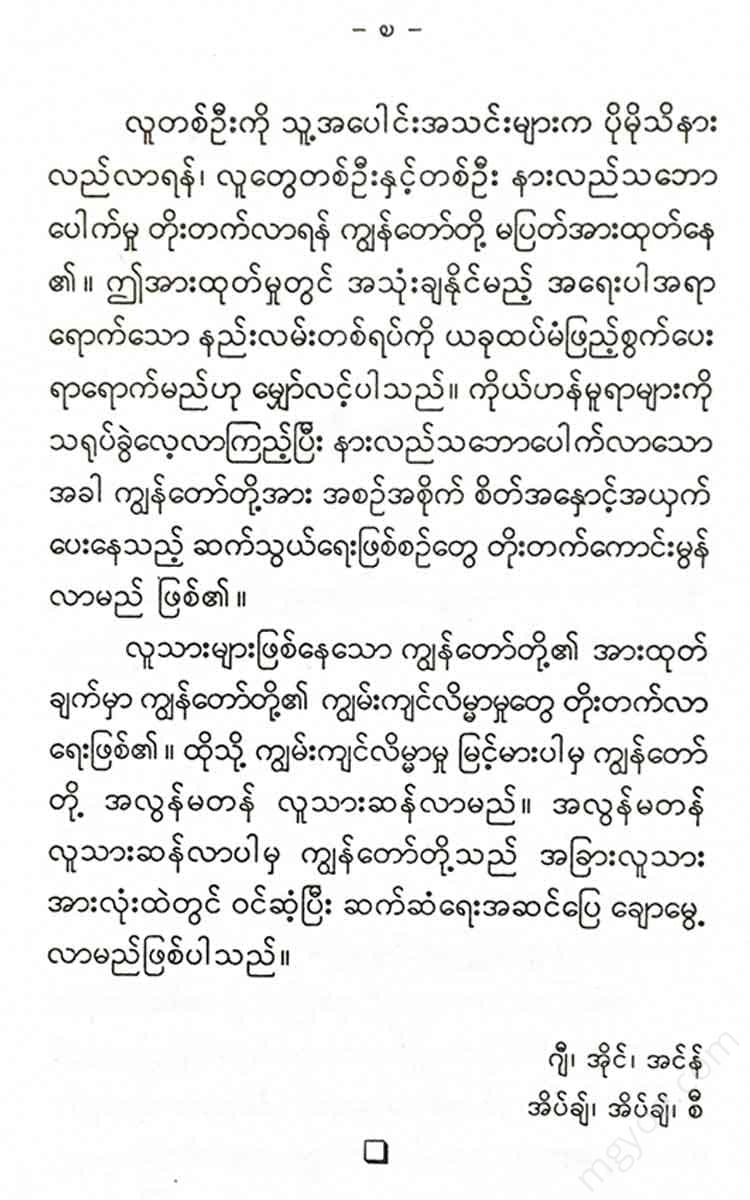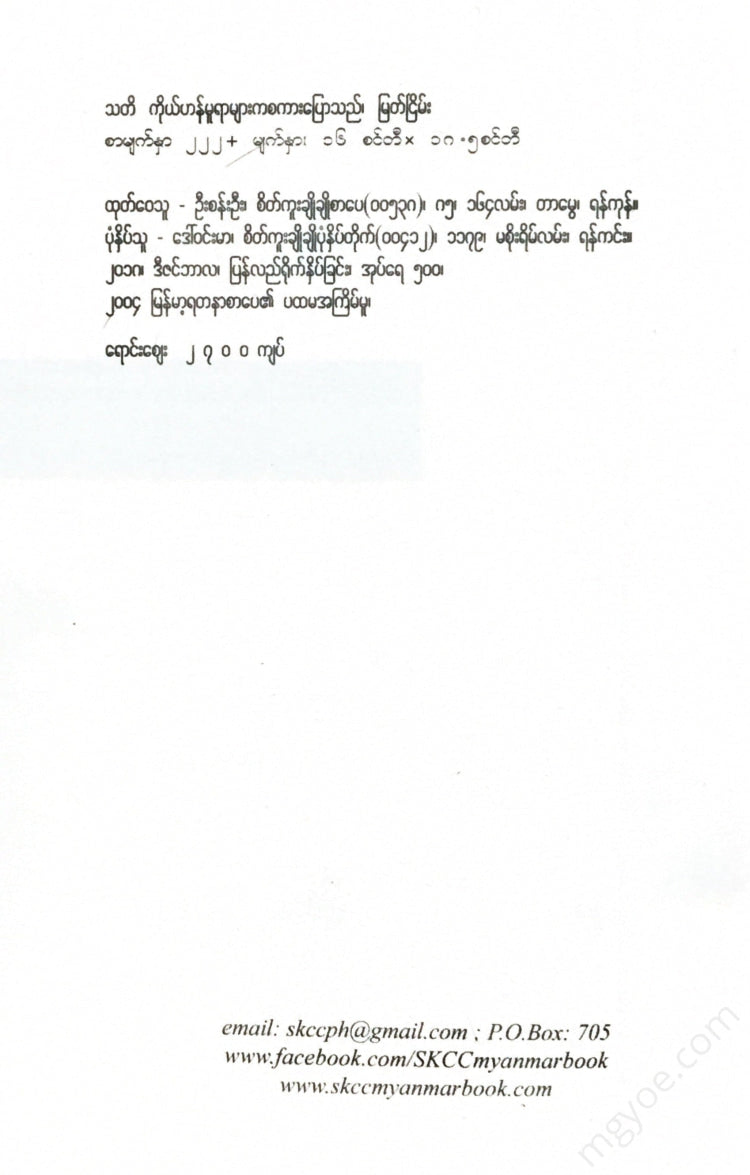စိတ်ကူးချိုချိုစာပေ
Myat Nyein - The self-consciousness speaks
Myat Nyein - The self-consciousness speaks
Couldn't load pickup availability
We read books to gain knowledge. But more than that, the knowledge about the world that we need can only be gained by reading books, studying a wide variety of books.
Lord Chesterfield
"Letters to His Son"
The best place to observe all the emotions of a human being is an airport. Passengers are coming in and going out. At that moment, you can see a woman who is nervous about flying. She is crossing her arms as if to reassure herself, “This trip will be smooth.” Don’t you think people often say, “I have to check myself to make sure I’m not dreaming?”
You might also see a man waiting for his flight to take off, dreading getting on the plane. He would sit up straight, his back straight, his ankles together, his hands clenched into fists, and his thumbs would be rubbing together at the same time.
These gestures express a feeling of anxiety.
As you leave the passenger lounge, you will see three people. All three are on the phone. One (Figure 1) is standing tall and alert. His coat is fully buttoned. His demeanor suggests that the person he is talking to is someone very important to him. He may be a sales representative making a phone call to a customer. However, his demeanor is as if he were actually in front of the customer.
The second person's posture is relaxed. (Picture 2) He stands in a relaxed manner. He stands on his left foot, then on his right. His chin is pressed to his chest. He looks down at the floor and nods his head, saying, "Yes, yes." As I continue to observe him, I see that he seems to be at peace...
1. Sales representative
2. Husband
3. Lover
It's obvious. There's a possibility that he's bored with talking. But he's also trying to hide it. He seems to like the person he's talking to. Maybe the person he's talking to wants to be his wife (or maybe he wants to be an old friend).
By observing such body language cues, can you tell the posture of a man who is on the phone with his girlfriend? This third man will hide his face. He will either hunch his shoulder or completely turn his back to other people passing by. He will tilt his head to one side. He will also hold the telephone receiver gently as if it were a cherished object. (Figure 3)
As you walk towards the craft stall, you will probably see a family. You can tell they are a family because their walking patterns are so similar. Those who are greeted by family (or friends) as they arrive at the craft stall are often the happiest people to see. Their walk will be lively. They will be enthusiastic. Those who are waiting for their arrival will be looking around on tiptoe.
We have noticed the various movements of people in the airport. We have been able to make inferences about people just by observing their gestures. We can imagine their moods, their relationships, their situations, even the image of the person on the other end of the phone. | What we are now studying is how the gestures of the living world speak.
It is the actions and reactions of real people in the world. We are not studying situations in a laboratory, isolated from the living world. In short, we are studying the vast and profound realm of nonverbal communication. We are studying nonverbal communication that can enrich verbal communication, make it more meaningful, or even eliminate the use of words.
Now we have begun the task of studying and interpreting a person, just as we read a book and interpret it.
The real test (or) life
"It's become more visible, it's about twice as big as it was in its natural state."
Lewis Carroll
From “Through the Looking Glass”.
Manufacturers of new cars test their products repeatedly and thoroughly before they are released to the market. Yet, the system automatically locks the doors as soon as you start driving and reach nine miles per hour. When cars equipped with this system were released, complaints began pouring in.
The owners of these cars have been in trouble every time they go to a car wash. As the car moves through the cleaning line, the wheels are turned. When the car reaches nine miles per hour, the automatic locking system locks the doors. When the car reaches the end of the cleaning line, the drivers cannot open the doors. They cannot get in. So they have to call a locksmith to open the doors. Ford has even had to re-install the manual locking system.
Similarly, everyday situations are better testbeds for interpreting gestures. Better because interpreting gestures in labs is not perfect.
Our awareness of nonverbal communication arose from an interest that arose while teaching negotiation skills. We have given talks and seminars on negotiation skills in the United States and abroad. At each seminar, we have learned from the participants that nonverbal communication is extremely important in negotiations.
In fact, communication does not happen spontaneously, isolated from reality. For this behavior to occur, people must be involved. Words must be involved. And gestures must be involved. Only by considering these basic elements as a whole can negotiation skills develop.
The limitation in analyzing postures was the lack of systematic and comprehensive study of the postures of the participants. Now, by recording videos and studying postures in detail, the aforementioned limitation can be overcome.
Now we don't just study a single gesture. We also study a combination of gestures. Gesture clusters: (gesture-clusters). Gesture clusters convey a person's mental state. These gestures are called clustered gestures. Gestures that can be present together in a cluster include folded hands, interlocked ankles, and clenched fists. These gestures can occur simultaneously or one after the other.
“A person’s unconscious actions can be unconsciously responded to by another person without being brought to the level of consciousness,” wrote the great psychologist Sigmund Freud. Our reactions then become “unanalyzed information.” Once our subconscious mind determines that a person’s actions are not friendly, we stop consciously analyzing them and respond with unpleasant behaviors. Then these unpleasant behaviors can develop into aggressive behaviors.
Therefore, we, who are capable of thinking, should consider and criticize before responding to stimuli.
We must consciously study the gestures of others. We must analyze them. We must respond. If we can do this, we can improve our relationships before they deteriorate. We may re-examine our own gestures. Then we may realize that we have been jumping to conclusions about the other person's gestures. Or perhaps the gestures we consider unpleasant may be due to the other person's physical characteristics.
For example, a judge is listening to the arguments of the lawyers. The judge is pale. He is blinking his eyes. Then, he is very careful and thinks about each word, which worries the lawyers who are worried that his arguments will be ineffective. In fact, the judge is a person who has suffered a stroke. Therefore, he has physical weaknesses.
Similarly, different cultures can interpret the same gesture in completely different ways, which can lead to misunderstandings. However, there are also gestures that are not necessarily indicative of a current state of mind. These gestures are simply a matter of habit and are repeated over and over again.
Therefore, we should not keep the gestures of others that we encounter at our subconscious level, but rather raise them to our conscious level and analyze them. Only then will we be able to correctly interpret the meaning of those gestures.
This practice can be described as thinking beyond the subconscious level. In this way, we can go beyond the level of blindly interpreting the other person's gestures and gain "information."


